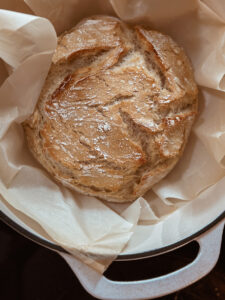
Make homemade sauerkraut? Yes, you can! It’s not only delicious, it also contains many more beneficial bacteria, enzymes and nutrients than most store-bought kraut. It’s really, really “good for your gut.” In this article, one of Lehman’s own shows you just how easy it is:
Doug Hamelink’s homemade sauerkraut is a popular dish here at Lehman’s! His wife, Kathleen, is a long-time customer service rep for Lehman’s. Doug has come in to help out during seasonal rushes. They’re definitely part of the Lehman’s family. Our warehouse staff took Doug’s recipe and made kraut last year, using products right off the shelf, including fermenting crocks and stompers.
Doug has been making sauerkraut the old-fashioned way for over 30 years. “When my wife and I moved to the farm back in the ’80s, an older fellow that was a neighbor out there taught me how to make kraut.”
Doug’s kraut is highly sought after here at Lehman’s. He took some time to describe his methods for foolproof fermented goodness.

“It’s not hard to do,” he says. Normally, Doug fills a #10 crock when he makes sauerkraut. (Our 5-gallon crock works well, too.) He uses the Triple Bladed Cabbage Cutter to shred his cabbage, and then adds salt, packing the crock in stages.
“First, you take a large cabbage, and you want one big enough because you want a total of five pounds to start.” He cleans and trims each cabbage, cuts the cabbage into quarters, and shreds into a large stainless steel bowl, weighing on a kitchen scale until he’s accumulated five pounds of cabbage. Although he prefers working with larger heads for efficiency’s sake, he notes that you can certainly use multiple smaller heads too. “When you’re shredding the cabbage, you don’t want to use that core,” he says. “It won’t pickle at all, it just won’t be right. Make sure it’s cut out as much as you can, and don’t shred it into the kraut.”

“Once your cabbage is shredded, put it in the crock. Then you sprinkle three tablespoons full of salt over it, and and you use something to stomp it down, to make the juices come out of that cabbage.” Doug uses an old Louisville Slugger baseball bat for this, but purists insist on a flat-bottomed stomper, saying it breaks down the cabbage more evenly.
Continue shredding, salting and stomping, says Doug, “until you run out of cabbage or your crock is nearly full.” He prefers to fill his crocks as fully as possible.
The cabbage in the crock should be covered by the salty juices you’ve created by stomping the shredded cabbage down. “Keep pushing it down until all the cabbage is covered by that juice. I put a plate on top, then, to seal it. The plate will need to be weighted down so it doesn’t float on the juice, so I fill up a clean gallon glass jar (similar to an empty pickle jar) with water, and put that on the plate. Then I put a towel over it all to keep it clean. It’ll sit five to six weeks.” Kraut makers can also use crock boards to weigh down the cabbage.

That time period is vital–it’s when your sauerkraut starts to ferment, and take on the wonderful texture and taste that only comes from homemade, handmade kraut. “You do have to keep an eye on it while it’s working. Check it every week or so. You may see a scum or what looks like mold on top. You can skim it off, and still have plenty of that juice to do the job.”
After the curing period, Doug does any needed skimming, takes the kraut out of the crock, puts it in freezer containers and pops it into the freezer. “I don’t can it, no. I do know people who do that, but we don’t care for it that way. I like it best fresh from the crock, and the frozen is as good.”
We agree – fresh from the crock or frozen is best. Canning will definitely remove the useful bacterias and yeasts that help the cabbage turn into tasty kraut, and make the kraut a nutritional powerhouse.
Editor’s note: This post originally published in September 2012.

































So good for you too!
We are going to do this, as commercial sauerkraut has sodium benzoate in it – which is an allergen for me.
Do you have a recipe for sourslaw?
I understand that canning kills the bacteria that make lacto-fermented kraut a nutritional powerhouse. But doesn’t freezing do the same thing — kill the bacteria?
Joe, my understanding is that freezing does not kill the good bugs. I freeze mine for that reason. Heat from the canning does kill them. You can also get a large crock and do a large batch over the winter. It will keep if you have it in a cool room and you can eat out of it like that. Like they used to do with barrels. In the spring when it starts to warm up too much, I put it in the freezer then.
Michelle Conti we will message you with a recipe from Lehman’s 55th Anniversary Cookbook!
Michelle Conti we will message you with a recipe from Lehman’s 55th Anniversary Cookbook!